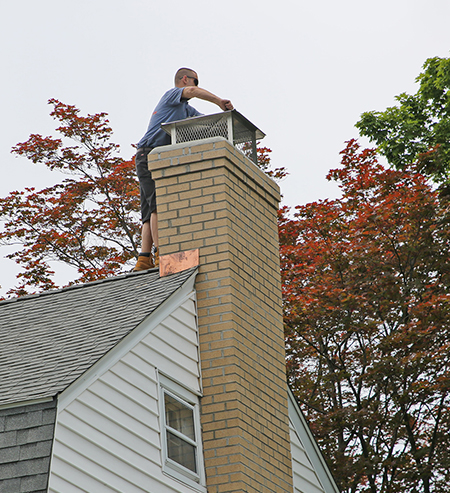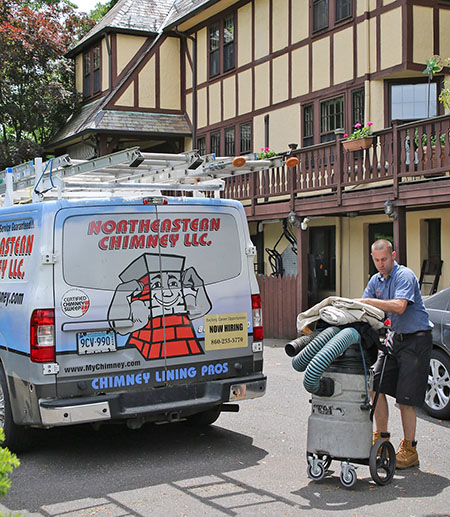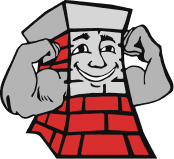Common Chimney FAQs
 While all of our chimney technicians love learning about the newest trends in chimney maintenance and safety, we know that many homeowners are looking for answer to simple questions about their chimney. We’ve made a list of the most common questions we hear and their answers to help you.
While all of our chimney technicians love learning about the newest trends in chimney maintenance and safety, we know that many homeowners are looking for answer to simple questions about their chimney. We’ve made a list of the most common questions we hear and their answers to help you.
1) How can I tell if my chimney is safe to use?
We hear this question a lot. The truth is that whenever you light a fire in your fireplace or stove, there is a risk. If your home’s chimney is damaged or full of creosote that risk dramatically increases. The best way to know if your chimney is in good condition to use is to have it inspected by a chimney sweep that has been certified by the Chimney Safety Institute of America (CSIA). Spotting warning signs on your own, without the right training and equipment, is difficult.
After an inspection, a certified chimney sweeps will let you know if the chimney looks healthy or if there are any problems that need to be fixed before you can use your fireplace or stove. For liability reasons, most chimney sweeps will not say that a chimney is safe. They can say that it looks healthy or has no apparent problems.
2) How can I tell if my chimney needs a cleaning?
The easiest way to find out if your chimney needs cleaned is to take a look inside. If you stick your head in the fireplace opening and look up, shinning a bright flashlight along the walls, you should be able to tell whether or not the walls look dirty. If you see shiny black coating on the walls or if the top of the chimney is blocked, you should schedule a cleaning before you use your fireplace or stove again.
The shiny black coating or tar-like substance that you may see along the walls of a chimney is creosote. Creosote is a highly flammable compound that’s created by burning wood and other fuels. It is much more difficult to remove than soot.
If you can’t see the opening at the top of the chimney, it is a sign that your chimney may be blocked by debris. You should make sure the damper is open just encase that is the reason you can’t see outside. If the damper is open and you still cannot see outside light, whatever is blocking the chimney will need to be removed before you use your fireplace or stove again.
3) Can I schedule a chimney cleaning without the inspection?
The answer to this question is simple: No. It is for your safety.
A chimney inspection is even more important than a cleaning. It ensures that there are no apparent problems with your chimney or fireplace that could cause a fire or carbon monoxide poisoning. Professional chimney sweeps that are CSIA-certified will always do a level 1, or visual inspection, during a cleaning to check for possible problems.
4) How can I tell if the flue is open?
This is actually a trick question. Many people don’t realize that the flue is the passage inside the chimney that the smoke travels up. It is always open. The damper is the vent inside of the flue that can be opened or closed.
You can find out if your damper is opening by looking up the chimney. If you can see light coming through the top, it is open. If you can’t, most likely, it is closed. There should be a handle near the fireplace you can use to open or close it. It is a wise idea to mark which position is open and which is closed so you don’t have to wonder in the future.
5) How can I find out if my chimney has a liner?
Most homes with a chimney built after the 1950s will have a liner. Typically, the original liner will be a clay tile liner though, if you have a newer home, it may be stainless steel. If you have a home built before 1950, it may or may not have a liner.
The only way to determine whether or not your chimney has a liner is to climb up onto the roof and check. If you stand above the chimney and look down, you should either see a round steel tube running down the side of the chimney or a clay tile tube.
6) What are the signs of a chimney fire?
Many chimney fires are silent. The only indicator that your chimney is on fire will be dark clouds of smoke or flames coming out the top of the chimney. There are a smaller number of chimney fires that are very loud. If you experience this type, you will know your chimney is on fire because you’ll hear a loud roar like a freight train is running through your home.
7) How do I choose a qualified chimney sweep?
 There are many scam artists that pretend to be chimney sweeps. It is very important to do a little extra leg work to make sure that you are hiring a reputable chimney sweep. There are 3 things you should look for when hiring a chimney sweep: proper credentials, full insurance coverage, and a good reputation.
There are many scam artists that pretend to be chimney sweeps. It is very important to do a little extra leg work to make sure that you are hiring a reputable chimney sweep. There are 3 things you should look for when hiring a chimney sweep: proper credentials, full insurance coverage, and a good reputation.
The Chimney Safety Institute of America (CSIA) is the primary professional organization in the U.S. that trains and certifies chimney technicians. The National Chimney Sweep Guild (NCSG) provides on going education. You should look for a chimney sweep that has been certified by CSIA and is an active member of the NCSG.
The chimney service you hire should be able to provide you with proof that they are fully insured. This means that, if anything goes wrong while they are working on your home, the damage will be covered.
Ask them for references so that you can speak to other people in the area who have used their services before. It is also a good idea to do a quick Google search and reach out to your local Better Business Bureau to make sure there are no complaints against them.
We hope that we’ve been able to answer your questions. If you have a question that you don’t see here, leave it for us in the comments or give us a call!


